How do financial institutions use Chainlink to unleash the full potential of tokenization?
Written by: Ryan Lovell
Translated by: TechFlow
Chainlink is the core infrastructure needed to move tokenization in capital markets from the conceptual validation stage to the production stage. Chainlink's role in supporting capital markets is essential for three key tokenization use cases:
- Enabling secondary markets for tokenized assets by allowing them to settle on any blockchain (public or private).
- Facilitating delivery versus payment (DvP) workflows by executing single-chain or cross-chain atomic transactions and ensuring the irreversible exchange of assets between blockchains to eliminate transaction failures.
- Synchronizing on-chain and off-chain systems by supporting communication between traditional infrastructure and blockchains.
Next, we will explore the current state of tokenization in capital markets, introduce Chainlink, and then look at real-world cases of how financial institutions can leverage Chainlink to unleash the full potential of tokenization.
Current State of Tokenization
Since 2017, efforts to tokenize assets in capital markets have mainly remained in the conceptual validation stage. While some institutions have announced the tokenization of traditional assets such as bonds, these experiments have primarily focused on the initial issuance of assets. For example, an investment bank as the asset issuer may tokenize bond notes, acquire them, and quickly mature the notes. Other successful use cases, particularly those related to banking and financial transactions (such as Broadridge's DLR and HQLAx), are specific applications managed by a single central entity.
Both examples highlight a common problem: the friction caused by the lack of seamless connections between various ecosystems and applications. Particularly noteworthy is the relative absence of active participation by asset managers and owners, despite their crucial role in creating sufficient liquidity. Their participation requires robust enterprise-level infrastructure to establish the necessary connections and facilitate the formation of secondary markets. This interoperable infrastructure should seamlessly integrate into existing internal systems without causing significant disruptions. Ultimately, each additional link will enhance the overall utility of blockchain-based financial products.
Chainlink: Connecting Existing Infrastructure with Blockchain Networks
Chainlink is an enterprise-level infrastructure that enables financial institutions to establish necessary connections between blockchains (on-chain) and existing infrastructure (off-chain). If your existing technology stack requires "blockchain operations," simply integrate it with Chainlink to connect to public and private blockchains.
Chainlink provides a suite of services that facilitate the transfer of data and tokens between blockchains, enabling bidirectional communication between blockchains and external systems, as well as various computational services for privacy, automation, and more. Three Chainlink services particularly relevant to tokenization in capital markets include:
- Cross-Chain Interoperability Protocol (CCIP) - An interoperability protocol for blockchains that serves as an abstraction layer and cross-chain messaging protocol, enabling existing infrastructure to communicate with any public or private blockchain and instruct smart contracts to send arbitrary data and transfer tokens between blockchains.
- Proof of Reserve - A decentralized network that verifies or proves cross-chain or off-chain reserves supporting tokenized assets, providing transparent on-chain audit trails for consumers, asset issuers, and smart contract-based applications.
- Functions - Institutions can provide services for any asset on any blockchain by synchronizing off-chain events or data with on-chain operations. It can synchronize any off-chain events or data, such as position settlement instructions, corporate actions, proxy voting, ESG data, dividends and interest, and net asset value.
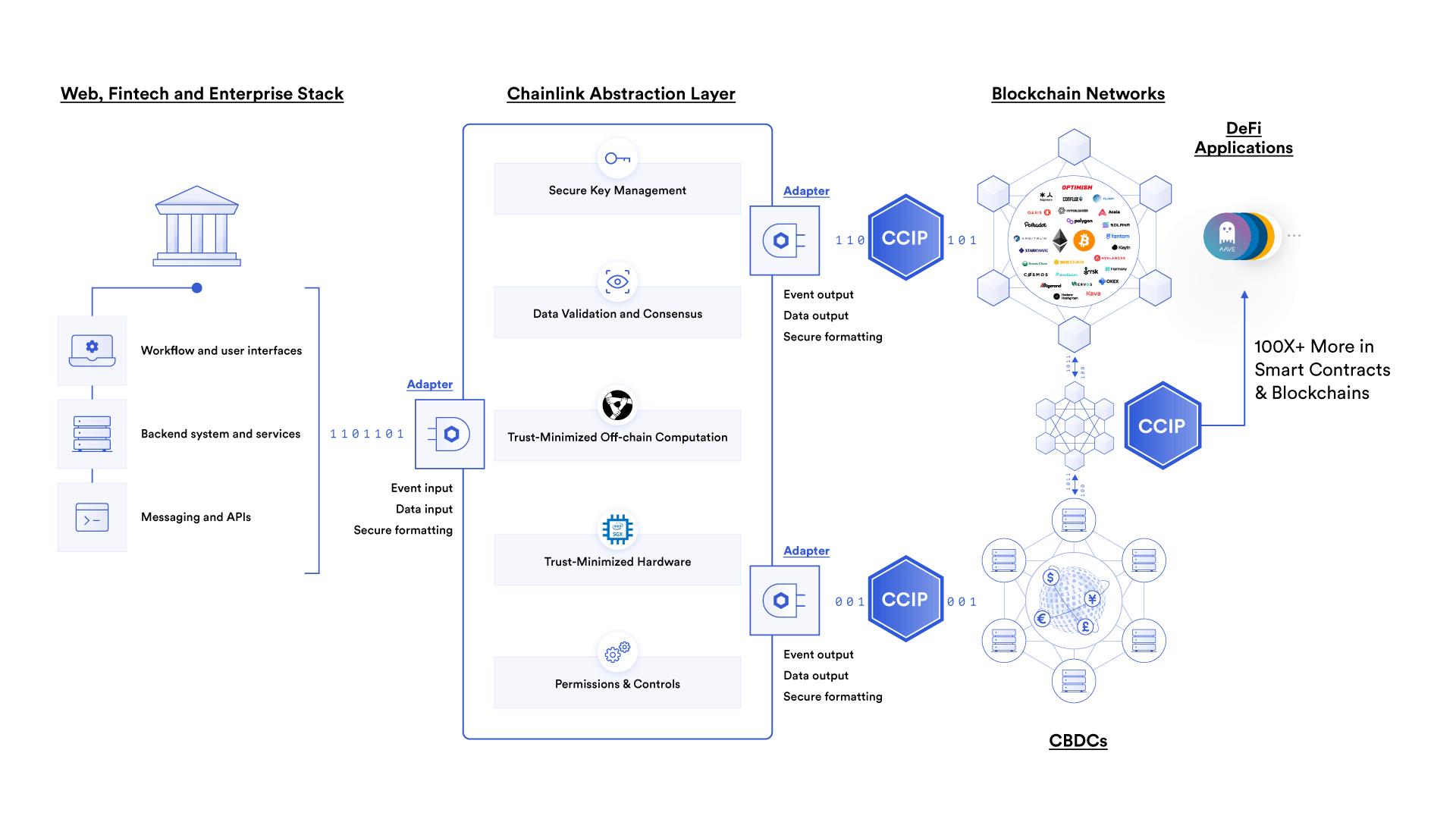
Chainlink has successfully facilitated over $8 trillion worth of transaction value for blockchain applications. The exceptional security standards of the Chainlink network are pioneered by a world-class research team and enforced by independent, Sybil-resistant nodes operated by leading enterprises such as Deutsche Telekom MMS, LexisNexis, and Swisscom in the decentralized oracle networks (DONs). Chainlink adopts a deeply defensive approach in development, maintaining high availability and tamper resistance over the years, even in the most turbulent and unpredictable industry conditions.
Real-World Applications of Tokenization Enabled by Chainlink
The following section is divided into three use cases: secondary markets, DvP, and on-chain/off-chain synchronization.
Secondary Markets
Secondary markets are crucial for the efficient operation of capital markets. They facilitate liquidity and price discovery by providing a platform for investors to trade previously issued financial instruments. Currently, financial markets rely on central securities depositories (CSDs) and custodian banks to maintain records of securities holdings. These securities can freely move from one custodian bank to another through a set of message standards from various front, middle, and back-office systems. This interconnected infrastructure not only supports the operation of secondary markets but also contributes to the overall stability and resilience of the global financial system.
Chainlink enables the realization of secondary markets for tokenized assets in three different ways:
1. Connecting buyers and sellers on different blockchain platforms
Business Background
Most bonds and illiquid assets are traded over-the-counter because of their heterogeneous nature. To bring the tokenization of bonds and illiquid assets to the production stage, the same liquidity platforms (such as MarketAxess and TradeWeb) need to be able to list these tokens from market makers' inventories or allow them to set prices. A component of market makers setting prices is based on liquidity risk—how quickly they can sell their inventory to clear their books by the end of the trading day. To maximize liquidity and achieve attractive pricing spreads matching or improving upon traditional issued assets, tokenized assets must be able to settle on any blockchain that asset managers and owners want to use.
Chainlink's Role:
- Chainlink CCIP provides a single integrated gateway for financial institutions to communicate with any public or private blockchain.
- Chainlink CCIP enables tokenized assets to be available on any blockchain, transforming them from single-chain assets to any-chain assets.
- Chainlink CCIP facilitates secure cross-chain DvP settlement through atomic transactions.
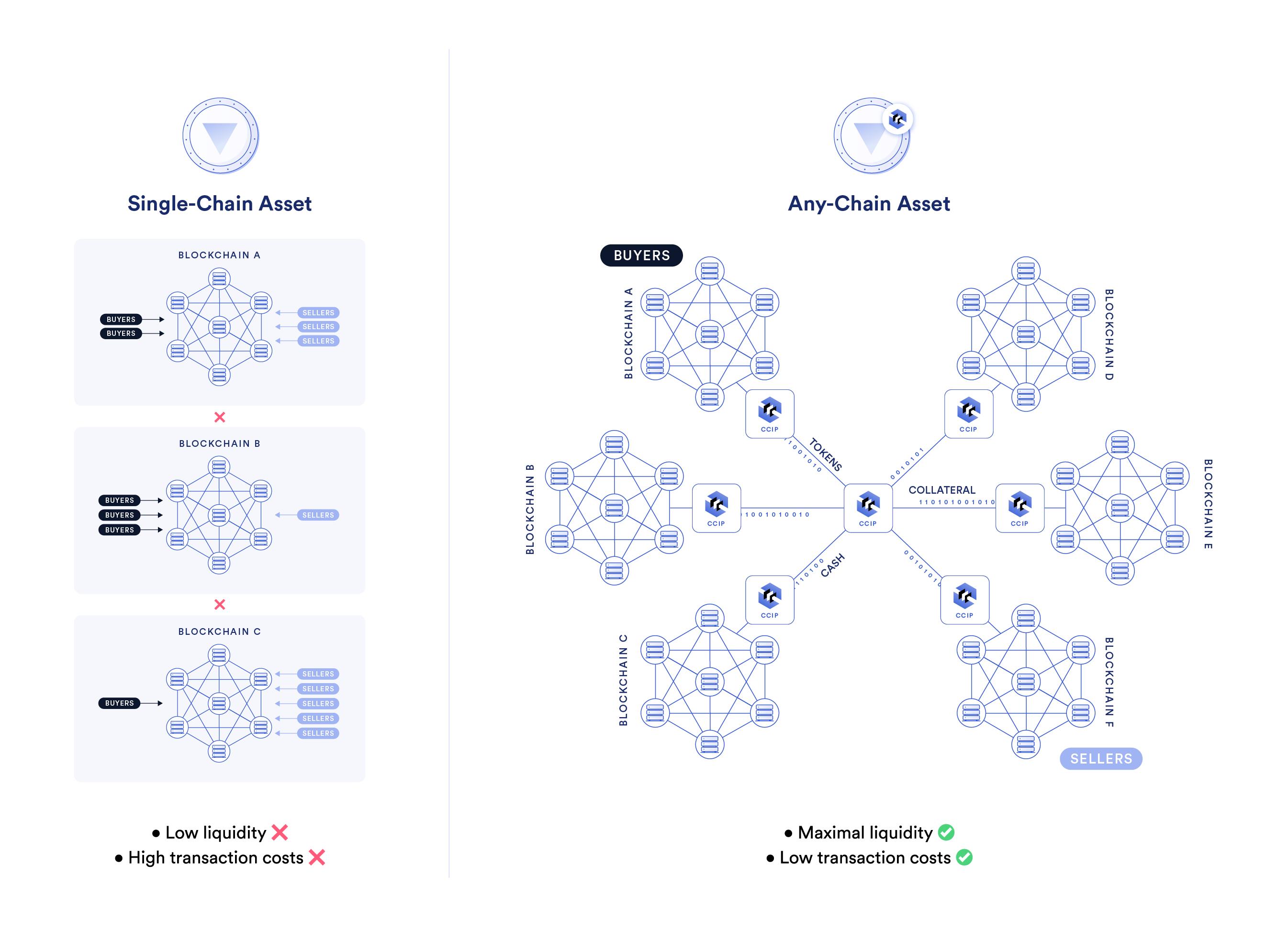
Example workflow utilizing Chainlink CCIP:
- Asset management company A needs to sell BondToken, which is currently issued on public chain 1 and held by a fund custodian.
- Asset management company A's trader logs into MarketAxess to view the bid-ask spread from dealers in the OTC market. Dealers can offer tighter spreads because they know this asset is enabled with Chainlink CCIP, meaning it is an any-chain asset that can settle on any public or private chain.
- The trader pays a small spread to move BondToken from public chain 1 to private chain 1 for the dealer to hold.
- Asset management company B on private chain 2 wishes to purchase BondToken.
- The dealer quotes a price and reaches an agreement. CCIP moves BondToken from private chain 1 to private chain 2.
2. Seamless integration of traditional infrastructure with blockchain networks
Business Background
Market participants in the financial industry have been slow to adopt new technologies like blockchain because many of them still rely on traditional systems. These systems guarantee significant value, and the cost and risk of replacing or developing new connections are exceptionally high.
In the past few years, financial institutions have conducted hundreds of blockchain proofs of concept. However, few projects have entered the production stage, primarily due to issues with integrating blockchain into core business infrastructure. This connectivity problem exacerbates the increasing number of blockchain ecosystems they may need to interact with.
Chainlink's Role:
- Chainlink CCIP connects existing infrastructure with any blockchain, enabling financial institutions to interact with tokenized assets without modifying traditional systems, such as through Swift messages, APIs, hosts, and other traditional formats.
Example scenarios implemented by CCIP:
- An order management system can only convey instructions through Swift messages, so I want to be able to communicate with any blockchain through Swift.
- As a bank custodian, I want to be able to communicate with any blockchain through my wallet infrastructure or client application.
- My middle office needs confirmation and status updates on token transfers, such as pending, completed, or failed.
- I want to publish data from an FTP server or Excel spreadsheet to smart contracts on the blockchain.
- I want to publish data from a host MQ connection to smart contracts on the blockchain.
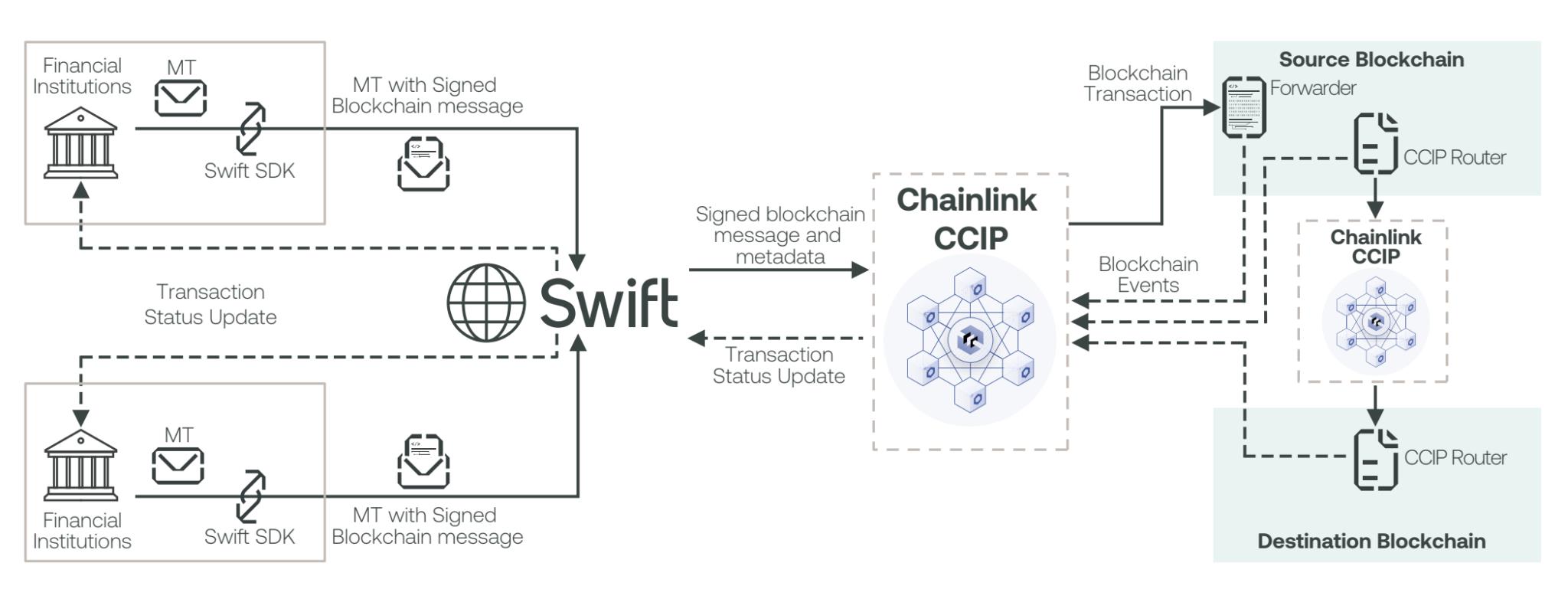
3. Providing blockchain interoperability standards for the capital markets industry
Business Background
In the ever-evolving landscape of information technology, large financial institutions inherently rely on three fundamental pillars: standards, reliability, and security. Standards provide a common language for collaboration, reliability enhances confidence in service continuity, and security protects against malicious threats.
Blockchain interoperability standards are crucial for supporting a globalized market of tokenized assets. However, to date, attempts to achieve interoperability have often been controlled by central entities, involved fragmented technology stacks, or required financial institutions to engage in point-to-point integrations with each new private or public blockchain. With hundreds of blockchains in existence and the potential for more, financial institutions need a widely adopted blockchain interoperability standard across the industry.
Chainlink's Role:
- Chainlink CCIP is an enterprise-level infrastructure that enables financial institutions to standardize the issuance, retrieval, and settlement of tokenized assets across the industry.
CCIP as a blockchain interoperability standard for capital markets will provide multiple benefits to financial institutions.
- Standardized Communication: Consistent communication reduces the need for errors, misunderstandings, and manual interventions.
- Automation and Straight-Through Processing (STP): Transactions can seamlessly flow from initiation to settlement without manual intervention at each step.
- Global Coverage: Seamless communication and transactions between entities in different countries facilitate cross-border trading, payments, and investments.
- Reduced Operational Costs: Standardized communication and automation reduce operational costs by minimizing the need for manual data entry and verification.
- Integration with Other Systems: Messages can be integrated with other financial systems and platforms, such as trade matching, risk management, and order management systems.
Delivery versus Payment (DvP)
Delivery versus Payment (DvP) is a key concept in financial transactions, especially in the securities market. It reduces counterparty and settlement risks by ensuring the simultaneous transfer of assets and corresponding payments. DvP plays a crucial role in maintaining the integrity of transactions, preventing one party from delivering assets without receiving the agreed-upon payment, and vice versa. Enabling DvP on the blockchain is essential to unleash the full potential of tokenized assets, as it allows a wider range of asset classes to be issued on-chain.
Real-World Examples
To establish a fully functional digital asset ecosystem, cash transactions must be incorporated into various DvP workflows. Banks and central banks are preparing to issue cash tokens, such as tokenized cash deposits and central bank digital currencies (CBDCs), which may initially use their proprietary private chains. Their clients, primarily asset management companies and owners, must be able to freely use these cash tokens to purchase assets in other blockchain ecosystems. However, to increase the utility of cash tokens, settlement risks must first be minimized.
Chainlink's Role
CCIP manages single-chain and cross-chain atomic settlement scenarios involving tokenized securities and tokenized cash. CCIP supports multiple interoperability primitives for building various cross-chain workflows (see example diagrams below) and eliminates transaction failures in cross-chain asset exchanges.
Key Steps:
- Bank A issues an institutional deposit token, BankCoin, on a private chain (i.e., cash chain), backed by cash and short-term fixed income instruments.
- Asset manager A, a client of Bank A, maintains a $5 million cash position in their fund held in BankCoin form on a private chain.
- Bank B issues BondToken on public chain 1 (i.e., token chain).
- Asset management company B, a client of Bank B, purchases BondToken in the initial offering and holds it in one of their funds.
- Asset management company B wishes to sell BondToken as their fund has net redemptions for the day, and investors want to receive cash quickly.
- Asset management company A and asset management company B match the trade on an OTC trading platform. They then send token instructions to CCIP to facilitate the atomic DvP trade between BondToken and BankCoin.
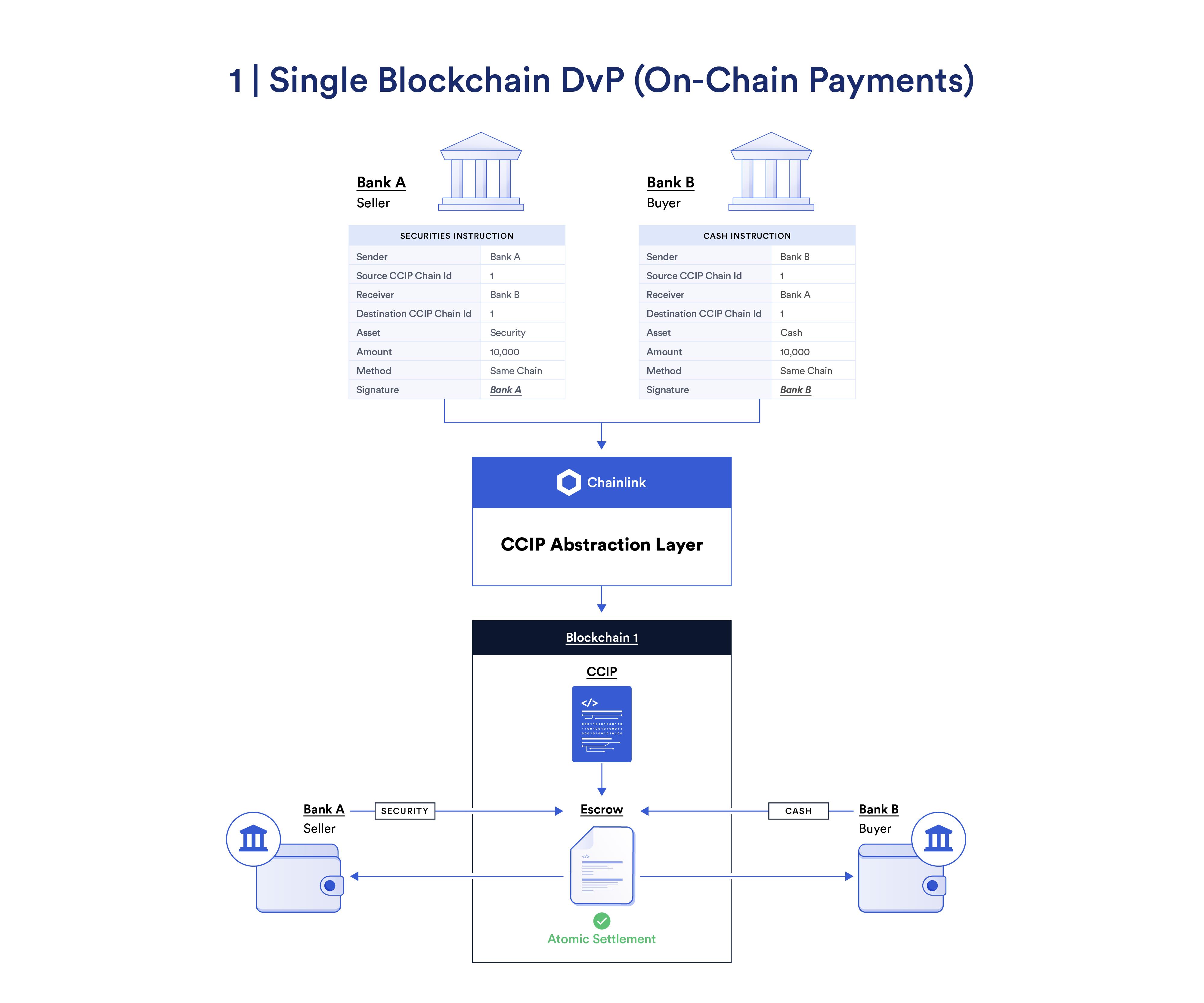
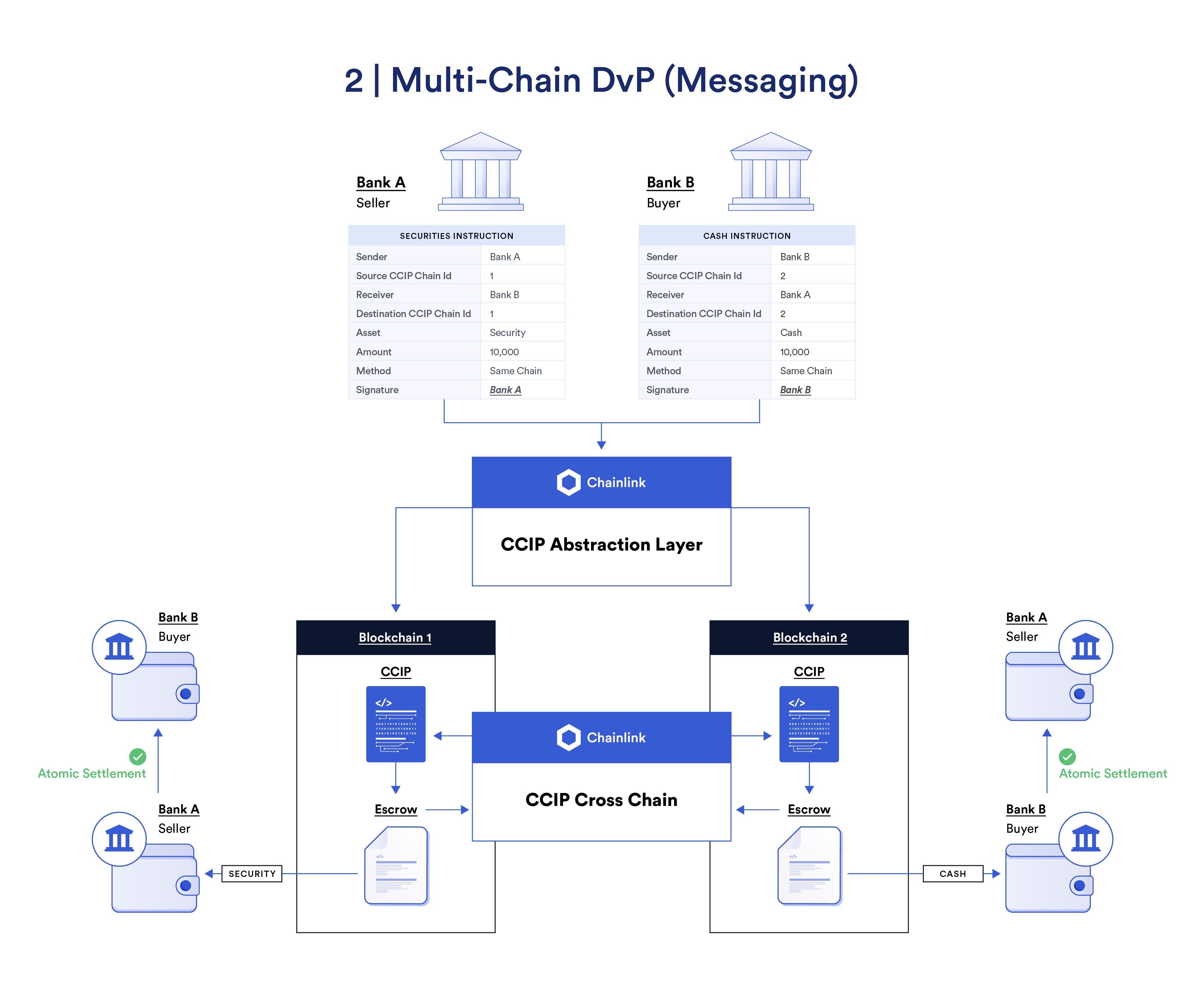
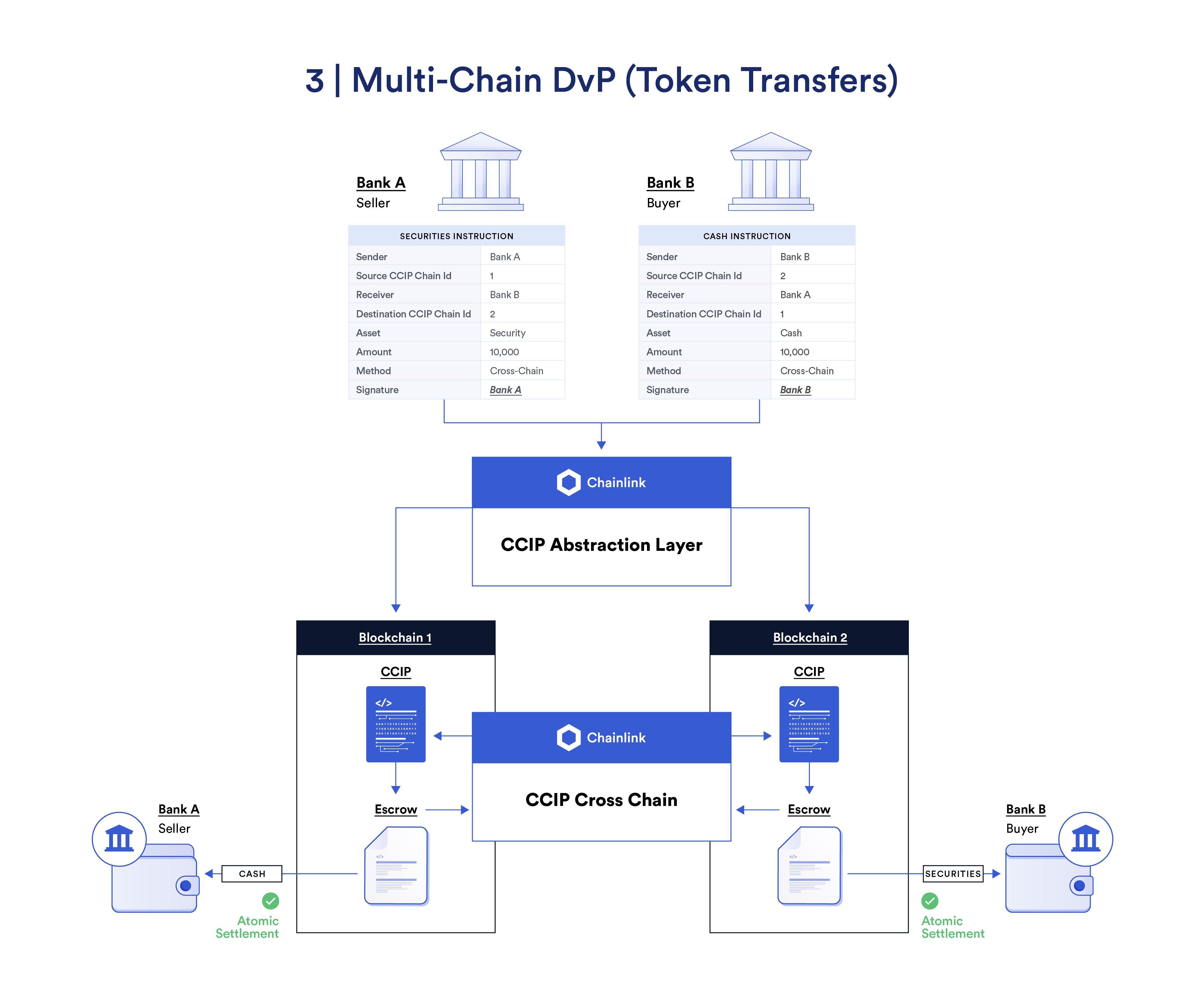
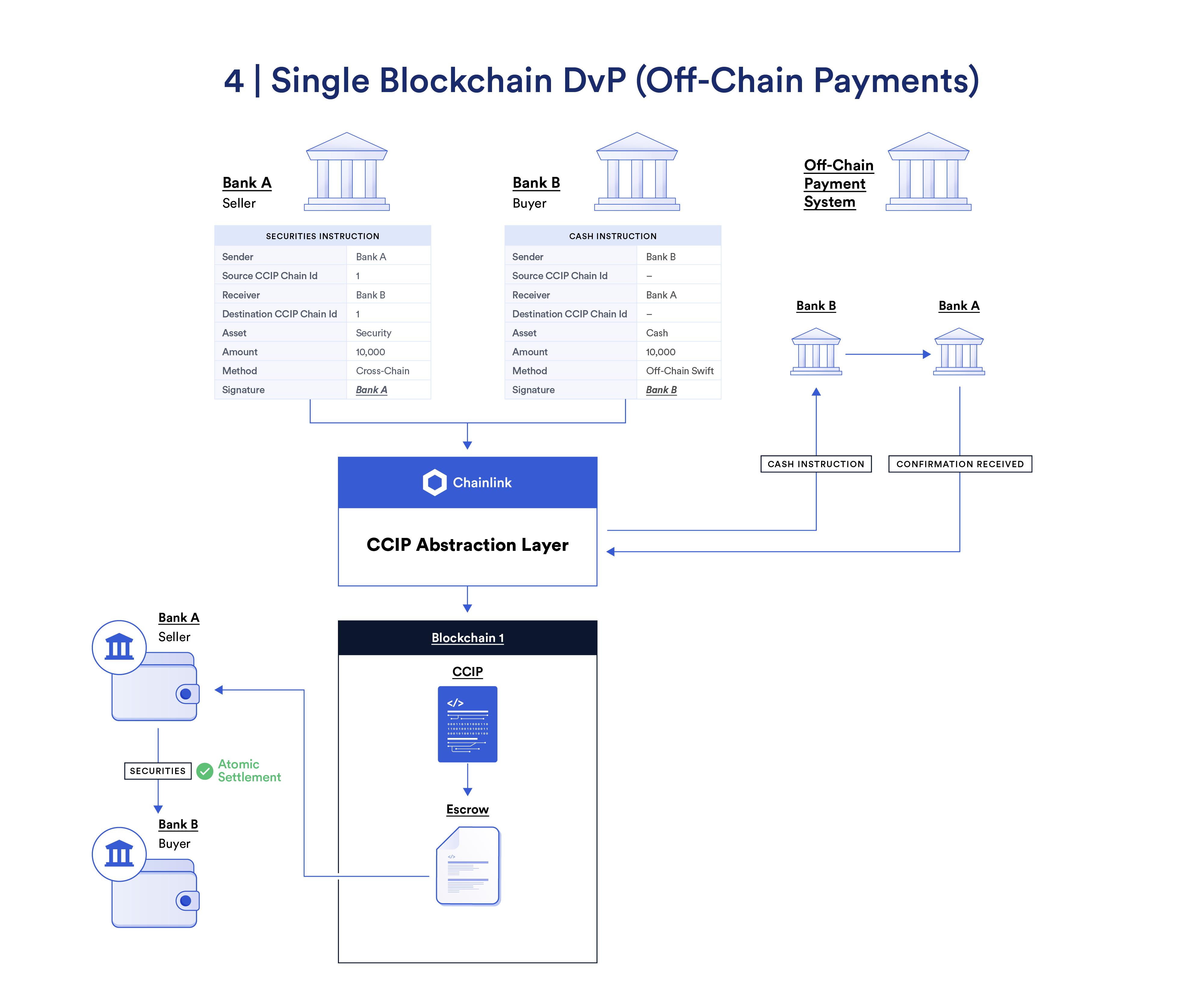
On-Chain and Off-Chain Synchronization
Establishing synchronization between off-chain traditional systems and on-chain blockchain ecosystems has profound benefits as a key support for improving operational efficiency, transparency, compliance, and enhancing customer experience. Here are some examples:
- Operational Efficiency: Reconciliation of assets based on blockchain events or off-chain and on-chain records for real-time updates in internal systems.
- Transparency and Auditability: Providing real-time on-chain verification of off-chain asset reserves through encrypted validation of wallet-held assets or proof from top accounting firms.
- Compliance: Compliance oracles enable transactions between verified wallet addresses on any blockchain.
- Enhanced Customer Experience: Real-time provision of financial market data (such as pricing) for reserve assets to on-chain and off-chain, increasing user confidence in using blockchain-based financial products.
Business Background
Banks need infrastructure to verify off-chain asset reserves for ownership of tokenized assets on-chain. They also need to verify the proper storage and management of these off-chain asset reserves. This requires a robust and independent monitoring framework that is not influenced by each bank's infrastructure and ensures that there are no conflicts of interest between the asset issuer's claims about the collateralized assets. The composition, valuation, and valuation frequency of reserve assets are crucial to ensuring the reliability of tokenization for production use.
Chainlink's Role
Chainlink's Proof of Reserve provides data for various tokenized assets on the blockchain, while Chainlink's Functions enable off-chain data required for completing financial processes to enter the blockchain.
Real-World Examples
- Bank A wants its clients to use cash/deposit tokens on various blockchains.
- Bank A selects a custodied bank account to manage the traditional asset portfolio supporting deposit tokens. A portfolio is chosen, consisting of cash and short-term treasury bills.
- Bank A utilizes Chainlink's Proof of Reserve to provide real-time market values for the assets supporting deposit tokens to its clients. The bank can provide the valuation itself or allow third-party auditors access to its custodied account. This provides transparency and confidence for clients to use deposit tokens in capital market activities and ensures that the token supply does not exceed the market value of the supporting assets (e.g., preventing infinite issuance attacks).
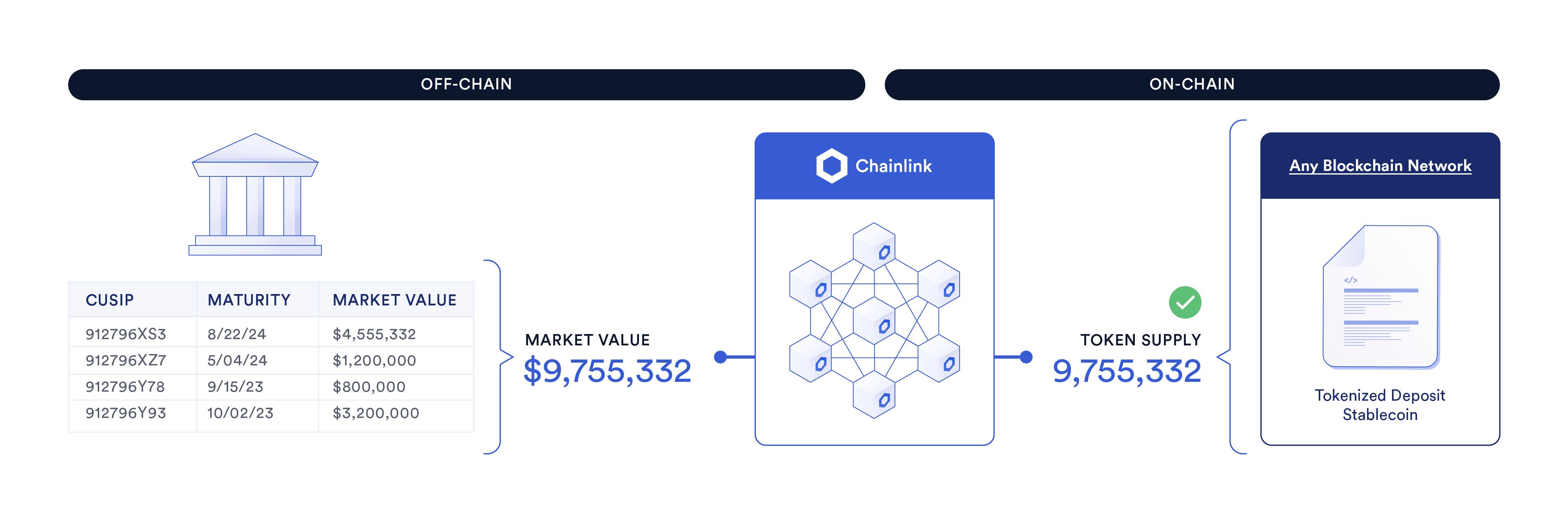
免责声明:本文章仅代表作者个人观点,不代表本平台的立场和观点。本文章仅供信息分享,不构成对任何人的任何投资建议。用户与作者之间的任何争议,与本平台无关。如网页中刊载的文章或图片涉及侵权,请提供相关的权利证明和身份证明发送邮件到support@aicoin.com,本平台相关工作人员将会进行核查。




